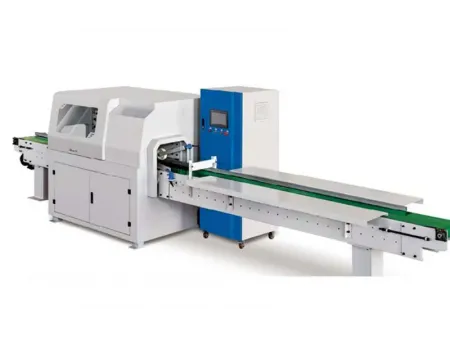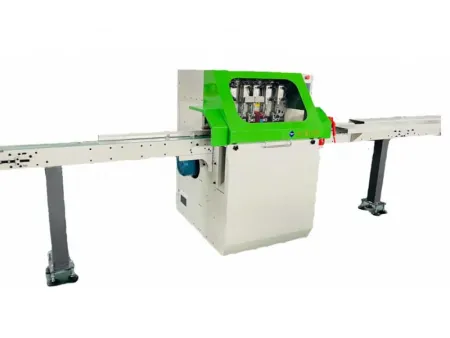Optimizing Cross-Cut Saw
Request a Quote
//Woodworking Machinery
Wood cutting machine for removing defects from wood workpieces
Woodworking Machinery
- Feeding length450-6000mm
- Total power9kW
- Overall dimensions6200×1300×1600mm
- Weight (kg)1800kg
Optimizing cross-cut saws offer high-speed and high-precision trimming of wood components, helping manufacturers remove defects from workpieces and optimize usable lengths. Built with a high-rigidity frame structure refined through stress analysis and stabilization treatment, they ensure long-term structural accuracy and resistance to deformation. Bottom-feed roller systems provide smooth feeding and precise positioning, even when handling bent or twisted wood. Spindles and feed rollers operate with synchronized toothed belts, minimizing power loss while maintaining precise transmission. Pneumatic control systems and actuators from world-class brands deliver reliable high-speed performance and long-term operational stability.
Functional Overview
- End trimming: Set the trimming length for squaring off the leading edge of the board.
- Defect marking: Operators manually mark defects using color indicators for the saw to identify and remove.
- Length-based sorting: Materials are pushed to designated positions according to the target cutting lengths.
- Post-cut sorting: Finished pieces are collected at the rear while defective or waste material is automatically removed.
- Yield optimization: Based on a pre-set cutting list, the software calculates the most efficient cutting combinations to minimize material waste.
- Length priority optimization: Prioritizes longer lengths first when combining cuts, organizing from longest to shortest to improve material usage.
- Grade-based optimization: Prioritizes higher-grade materials in the cutting plan, arranging cutting combinations from highest to lowest grade.
- Sequential optimization: Follows the defined cutting list order strictly, processing pieces in the sequence they appear.
- Quantity-based optimization: Combines length and quantity targets, dynamically tracking production data to meet required quantities efficiently.
- Zero waste optimization: When offcuts are identified as unusable, the software recalculates combinations to extend offcuts into usable lengths, minimizing scrap.
System Configuration
- Equipped with original, high-quality electrical components. The system combines manual and electrical controls for simple, intuitive operation. It runs on a 380V/50Hz power supply, with a 24V DC control circuit to ensure circuit safety. Key components are sourced from Schneider Electric and are assembled following rigorous system testing and multi-stage quality inspections to meet international safety standards.
- Utilizes Schneider Electric PLC (France), known for fast processing speed and stable performance, one of the top models among compact PLCs.
- Integrated with TECO servo drives, delivering high speed and high precision transmission. The motors support peak overload currents up to 300%, offering strong torque output.
- Fitted with a high-protection, stable-running motor from a reputable domestic brand, ensuring reliability in long-term operation.
- Intuitive human-machine interface (HMI) with a 10-inch touchscreen for easier and more visual operation.
- Uses SICK sensors (Germany), known for high recognition accuracy and fast response time, widely regarded as a leader in global optical sensor technology.
- Equipped with Airtac (Taiwan) pneumatic cylinders, five-way valves, and valve blocks. These components offer fast response and low control current, ensuring operational accuracy.
- All major spindle and drive parts use original factory components. The spindle adopts a dual-bearing design at key stress points based on mechanical load analysis, ensuring smooth rotation and long service life.
Specifications
| Mode | ||
| Feeding speed | 1-120m/min | 1-120m/min |
| Feeding length | 450-6000mm | 450-6000mm |
| Max. sawing cross-section | 120×10mm to 80×40mm | 230×85mm to 250×75mm |
| Saw blade speed | 1-5 times/second | 1-5 times/second |
| Saw blade diameter | 400mm | 500mm |
| Total power | 9kW | 11kW |
| Air pressure | 0.6MPa | 0.6MPa |
| Number of vacuum cleaner | 3 | 3 |
| Diameter of vacuum cleaner | Ø100mm | Ø100mm |
| Voltage | 380V/50Hz | 380V/50Hz |
| With intelligent speed control | Yes | Yes |
| Color sensor | Germany,Sick | Germany,Sick |
| Detection switch | Omron,Japan | Omron,Japan |
| Overall dimensions (mm) | 6200×1300×1600mm | 6300×1400×1700mm |
| Weight (kg) | 1800kg | 2300kg |
| Functions | Automatically cut off both ends Cut off defects after marking Fixed length sawing Prioritize sawing the longest dimension Zero waste | |
| Caution | Keep manual operation away from the saw blade to prevent personal injury | |
Features
- Sequential Cutting Mode
The cross-cut saw supports sequential cross-cutting based on the factory's material inventory and dimensional specifications. Once the desired cutting order is programmed, the system processes the wood pieces accordingly. It automatically aligns production with different product specifications and required combinations, ensuring consistency in sizing and output. Operators can input multiple lengths directly on the touchscreen interface in numbered sequence. After squaring the board's lead edge, the system proceeds to cut the material in the exact order of the listed dimensions.
Note: When using this mode, defect marking and scanning functions are disabled, as cutting follows a strict, pre-defined sequence rather than optimization logic. - Multi-Specification Cutting
The cutting system supports cutting multiple specified lengths from a single workpiece, making it ideal for custom furniture production. For example, when manufacturing a chair that requires four different component sizes, the operator can predefine these four specifications in the control system. The wood cutting machine will then cut each raw board precisely according to the preset sizes and in the programmed order. This ensures efficient material use, accurate dimensioning, and seamless integration with production plans that require a combination of different part lengths from each piece of lumber. - Repetitive Cutting of Identical Specifications
It allows for repeated cutting of the same specification within a single cutting cycle, which is especially useful for producing matching components in pairs or sets. For instance, when manufacturing a sofa that requires two identical front legs and two identical rear legs, the operator can input those two specifications with the desired quantities. If the raw material length permits, the optimizing saw will cut each board according to the set sizes and quantities in the defined sequence. This ensures consistent part matching, efficient use of materials, and streamlined batch processing for furniture components produced in pairs or multiples. - Cut-to-Mark Mode
This mode is designed for defect removal by following manually drawn reference lines on the surface of the wood. It enables precise, close-proximity cutting around visual defects such as knots, cracks, splits, and end grain irregularities. Operators use a dedicated marking pen to indicate areas to be removed, and the machine automatically scans for these marks and executes clean, high-accuracy cuts at the designated positions. This function is ideal for high-speed, high-precision removal of surface defects without affecting the usable portions of the board, helping manufacturers maintain both material yield and final product quality. It is particularly well-suited for operations such as finger-joint lamination or edge-glued panels where defect-free segments are essential for further processing. - Fixed-Length Cut-to-Mark Mode
In this mode, operators mark defects on the wood surface using a designated marking pen and input a fixed target length on the touchscreen. Once the material is loaded and the leading edge is trimmed, the system begins feeding and scanning for marked lines. If no defect mark is detected within the preset cutting length, the machine cuts the board according to the target dimension. However, if a defect mark is found before reaching that length, the system overrides the preset length and performs a cut directly at the mark. The cycle then continues, alternating between cutting at fixed intervals or at the next detected defect mark, whichever condition is met first. This function provides a balance between precision length cutting and defect removal, making it useful for applications requiring both dimensional consistency and quality material yield.




